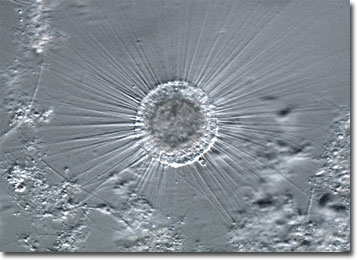Differential Interference Contrast Image Gallery
Sun Animalcules (Actinosphaerium Heliozoans)
Actinosphaerium is a genus of heliozoans, the members of which look similar to tiny sea urchins due to their spherical shape and radiating, spiny pseudopodia. Actinosphaerium species are multinucleate and may have diameters that reach up to one millimeter in length.

Similar to other heliozoans that are sometimes referred to as “sun animalcules,” Actinosphaerium species are radially symmetrical single-celled organisms. Also, their stiff pseudopodia extend in all directions and are composed of cytoplasm and intertwined helices of microtubules. The extensions are primarily used for capturing prey, which can then be incorporated into the body of the cell through a process known as phagocytosis.
Heliozoans are generally freshwater creatures and can frequently be found in lakes and ponds. Depending on conditions and food supplies, areas may contain large populations, the heliozoans quickly reproducing asexually through binary fission or budding. Suitable food sources for the organisms include algae, protozoans, and other tiny life forms. However, heliozoans generally will try to consume most anything that comes across their paths since they have little locomotive ability.
